Got those tiny, annoying bugs buzzing around your kitchen? You might be dealing with fruit flies! Don’t worry, it’s a common household issue, and thankfully, getting rid of fruit flies doesn’t require expensive solutions or harsh chemicals. You likely have everything you need right in your kitchen to create simple and effective traps. Recently, we faced a fruit fly invasion at home – a first in four years! This gave me the perfect opportunity to test and document seven different fruit fly elimination methods. Yes, spreadsheets and detailed notes were involved! Today, I’m sharing the most effective homemade fruit fly traps and guiding you on how to make them.
These DIY traps are incredibly easy to assemble using natural, household ingredients, making them both budget-friendly and chemical-free. If you prefer a humane approach, you can even release the captured fruit flies outdoors. We’ll explore humane trap options and also discuss essential tips to prevent fruit fly infestations from happening in the first place.
Understanding Fruit Flies: What Are They?
Fruit flies are small flying insects that are drawn to the sweetness of ripe fruits and certain vegetables, perfectly aligning with their name. They are also attracted to sugary and fermented drinks like beer, wine, and juice. You’ll often find them congregating around fruit bowls, garbage disposals, and even kitchen drains. They are about the size of a grain of rice and resemble small, tan or brownish houseflies, often with distinctive red eyes. Fruit flies are most prevalent during summer and late fall, coinciding with fruit harvest seasons.
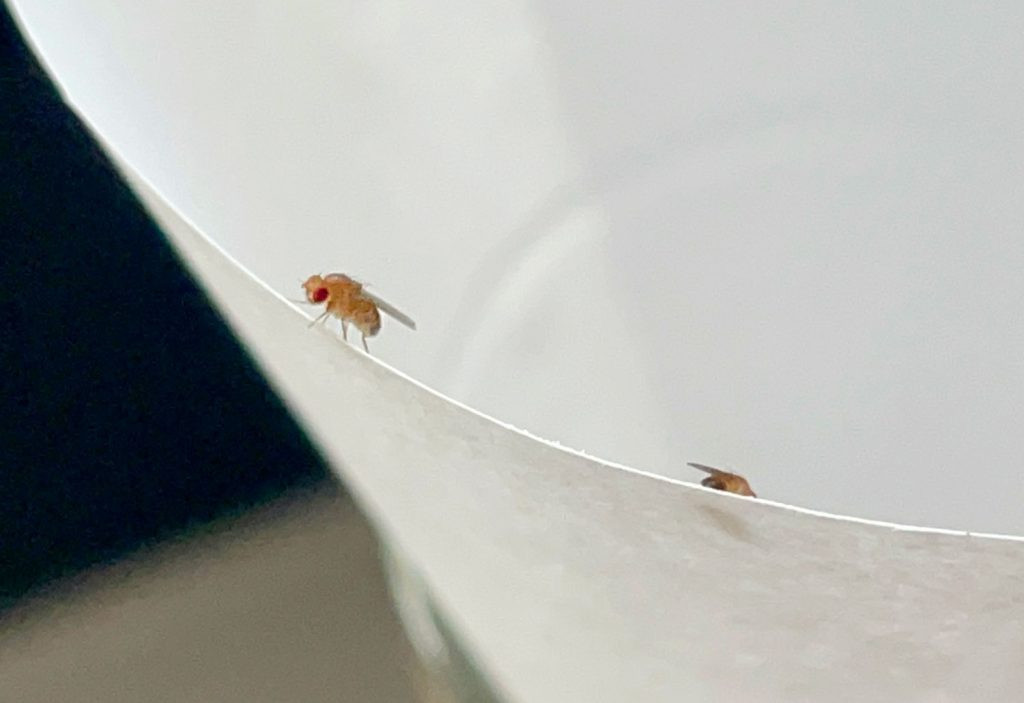 Close Up Of Fruit Fly On Paper Funnel
Close Up Of Fruit Fly On Paper Funnel
A fruit fly problem can start with just a few bugs hitching a ride on your groceries. However, female fruit flies are prolific breeders, capable of laying hundreds of eggs in their short lifespans, with eggs hatching in as little as 12 hours. They can reach adulthood within days, meaning a small number of fruit flies can quickly escalate into a large infestation. This rapid reproduction cycle is why swift action is crucial to eliminate fruit flies as soon as you notice them.
Identifying Fruit Flies: Fruit Flies vs. Fungus Gnats vs. Drain Flies
Fruit flies are often mistaken for other small household pests, particularly fungus gnats and drain flies. While all are small flying insects, accurate identification is key to choosing the most effective elimination method. The easiest way to distinguish them is by observing their location and noting their resemblance to larger insects.
- Fruit flies look like small flies. They are commonly found near fruit bowls, trash cans, and other decaying food sources.
- Drain flies look like small, fuzzy moths. They are typically seen near sinks, drains, and damp areas.
- Fungus gnats look like small mosquitos. They are usually found around houseplants, as they breed in moist potting soil.
If you’re unsure about the type of pest you’re dealing with, try one of the traps described below. If it attracts the insects in your home, you most likely have fruit flies.
4 Simple DIY Fruit Fly Trap Recipes
Getting rid of fruit flies doesn’t have to be a complex or expensive task. You only need a few common household items and a bit of patience. The fundamental principle behind each trap is simple: attract the fruit flies and prevent their escape. We tested these 4 DIY methods and found a clear winner. Since each method utilizes items you probably already have at home, trying multiple traps is easy. Think of it as a fun, mini science experiment in your kitchen! Here are the initial 4 methods I tested:
- Funnel Trap
- Plastic Wrap Trap
- Dish Soap Trap
- Rotting Fruit Trap
Let’s delve into the details of each method, including our findings on their effectiveness. Keep in mind that some traps work faster than others, and completely eradicating a fruit fly problem can take several days, regardless of the technique used.
#1: The Paper Funnel Fruit Fly Trap
This trap design lures fruit flies into a container through a narrow opening at the bottom of a paper funnel. Once inside, the flies struggle to escape through the same small opening.
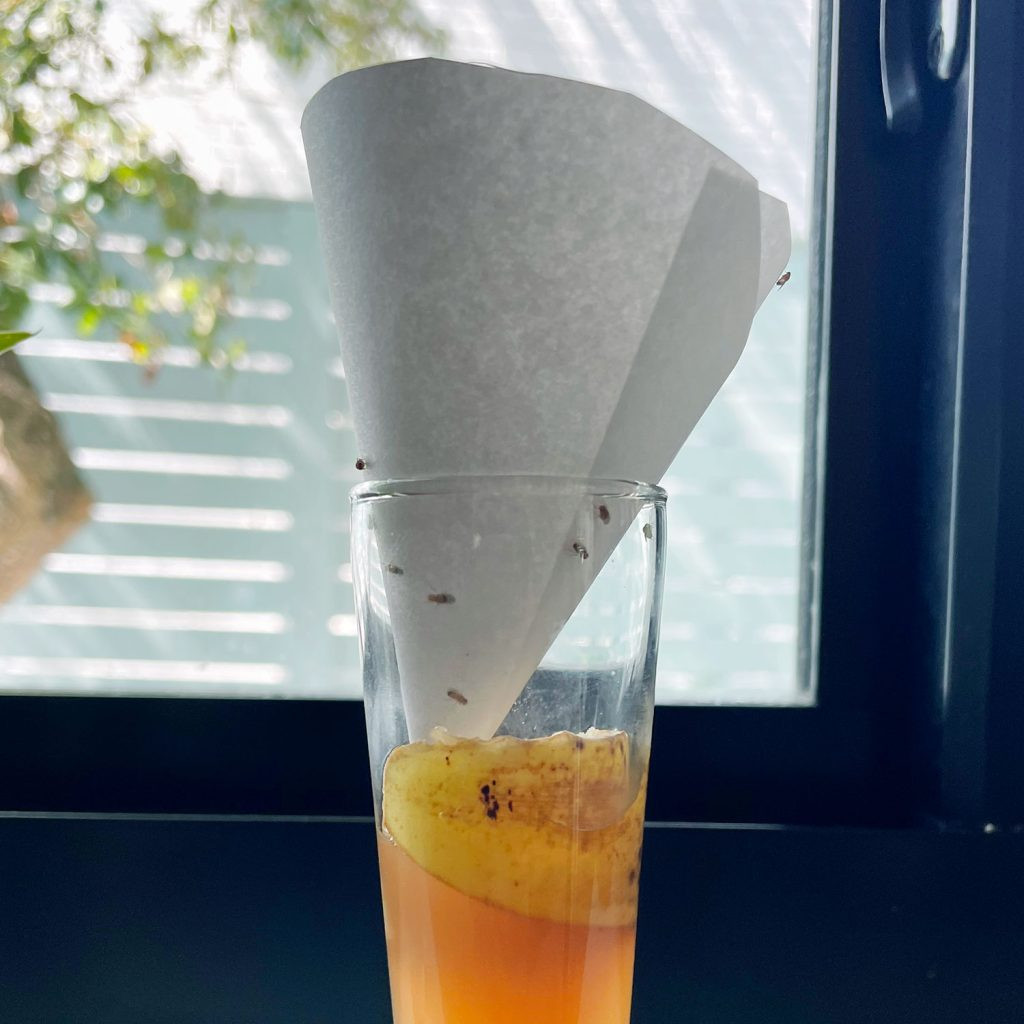 DIY Fruit Fly Trap With Paper Funnel
DIY Fruit Fly Trap With Paper Funnel
Materials you’ll need:
- A small, clear jar, cup, or container, ideally with a narrow opening
- A piece of paper or cardstock
- Tape
- Scissors
- Apple cider vinegar (ACV)
Instructions:
- Select your container: Choose a small, clear container like a repurposed food jar or a plastic bottle. A narrow opening is beneficial for this trap design.
- Add the attractant: Pour a small amount of apple cider vinegar, old beer, or wine into the container. These liquids are highly attractive to fruit flies.
- Create the paper funnel: Shape a piece of paper or cardstock into a cone with a very small hole at the tip. Secure the cone shape with tape. You can cut the opening at the tip after forming the cone if easier. The hole only needs to be about the size of a grain of rice.
- Assemble the trap: Place the paper funnel into the container opening. Adjust the funnel so it sits securely on the rim without touching the liquid. Ensure there are no gaps around the edges where flies could escape.
- Humane release (optional): To release captured flies, carefully take the entire trap outdoors, ensuring the funnel stays in place. Remove the funnel outside to allow the fruit flies to fly away.
While a store-bought funnel can be used, the opening is often too wide, which can allow trapped fruit flies to escape. A homemade paper funnel with a smaller opening is generally more effective.
#2: The Plastic Wrap Fruit Fly Trap
This trap utilizes the alluring scent of apple cider vinegar to attract fruit flies. They enter through tiny holes poked in plastic wrap stretched over the container opening but then struggle to find their way back out.
Materials you’ll need:
- Small, clear jar, cup, or container
- Rubber band
- Plastic wrap or a plastic bag
- Toothpick
- Apple cider vinegar (ACV)
Instructions:
The steps for creating this plastic wrap trap are very similar to the funnel trap.
- Choose your container: Select a small, clear jar, cup, or any glass container. Clarity is helpful for monitoring trapped flies, but even a can will work.
- Add the attractant: Pour apple cider vinegar into the container. Its scent will attract fruit flies. Old beer or wine are also effective alternatives, but regular white vinegar is not as attractive.
- Seal with plastic wrap: Tightly cover the container opening with plastic wrap and secure it with a rubber band. Saran wrap works well, or you can use a piece cut from a plastic bag.
- Poke small entry holes: Use a toothpick to carefully poke a few small holes in the plastic wrap. These holes should be just large enough for a fruit fly to enter.
- Humane release (optional): To release the trapped flies, carefully carry the trap outdoors without removing the plastic wrap. Once outside, remove the plastic wrap to let the flies escape.
Alternatively, you can create a similar trap using a metal jar lid. Use a hammer and nail to puncture small holes in the lid of a mason jar or old food jar.
#3: The Dish Soap Fruit Fly Trap
This method differs from the previous two by not requiring a cover. Instead, it uses a soapy surface to trap fruit flies. Note: This trap is not designed for humane release as the soap will coat the flies.
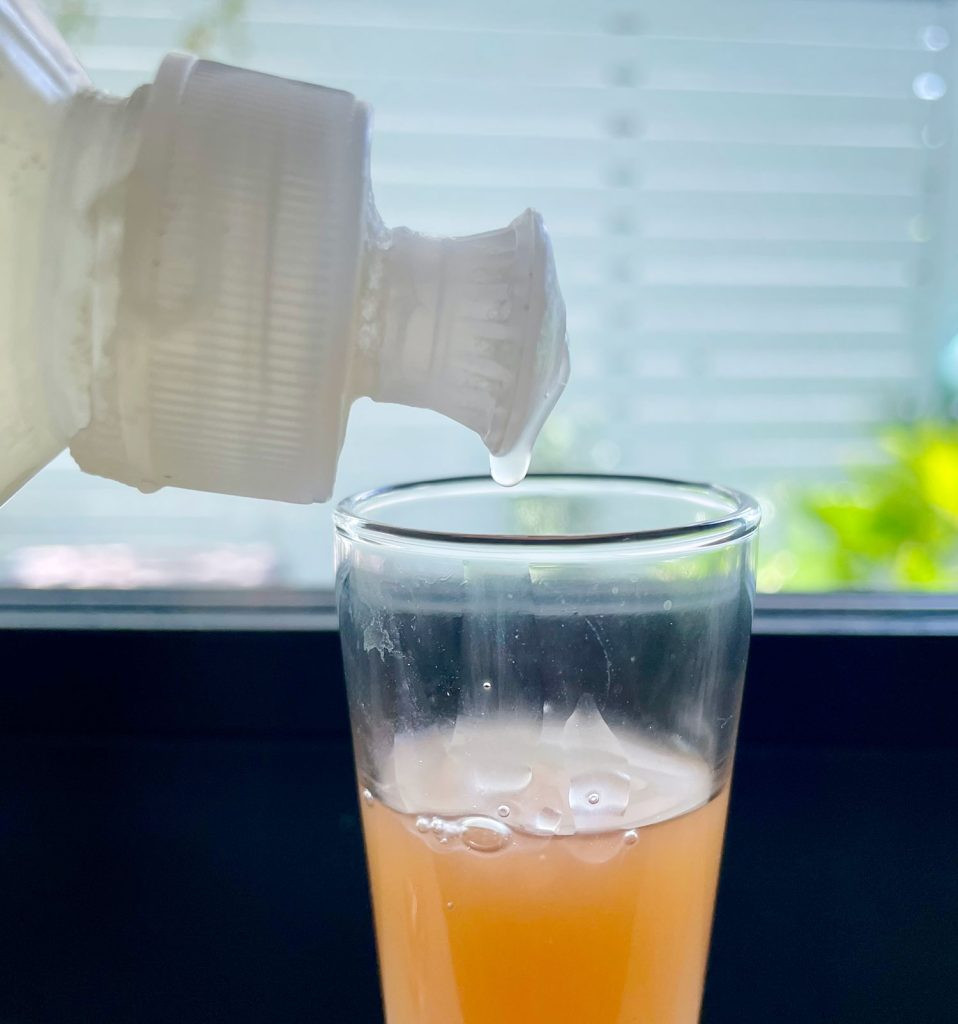 Dripping Dish Soap Into Apple Cider Vinegar For DIY Fruit Fly Trap
Dripping Dish Soap Into Apple Cider Vinegar For DIY Fruit Fly Trap
Materials you’ll need:
- Small container, bowl, or dish
- Dish soap
- Apple cider vinegar (ACV)
Instructions:
This trap is incredibly simple to set up.
- Pour in apple cider vinegar: Fill the bottom of a small container, bowl, or dish with apple cider vinegar. The scent acts as the primary attractant.
- Add dish soap: Add several drops of dish soap to the apple cider vinegar and gently mix. The soap reduces the surface tension of the vinegar, causing fruit flies to sink and drown when they land on the mixture.
For enhanced effectiveness, you can combine this technique with the plastic wrap or funnel traps. Simply add dish soap to the apple cider vinegar before covering the container. This adds an extra trapping mechanism.
#4: The Rotting Fruit Fruit Fly Trap
We also experimented with traps that replaced apple cider vinegar with fruit, leveraging fruit flies’ strong attraction to ripe and decaying fruit.
Materials you’ll need:
- Small glass jar, cup, or container
- Plastic wrap or paper funnel, depending on your chosen trap mechanism
- A small piece of fruit, such as a banana peel or apple slice
To make a rotting fruit trap, substitute apple cider vinegar with a piece of banana peel, apple slice, or peach in either the Plastic Wrap or Funnel trap designs. You can also enhance the apple cider vinegar traps by adding a piece of fruit. However, be prepared to replace the fruit every day or two to prevent unpleasant odors in your kitchen.
Determining the Best Fruit Fly Trap
As shown in these photos, we tested four different DIY trap combinations to determine the most effective method. The homemade traps we evaluated were:
- Plastic Wrap Trap with banana peel
- Funnel Trap with ACV + banana peel
- Plastic Wrap Trap with ACV + soap
- Dish Soap Trap with ACV
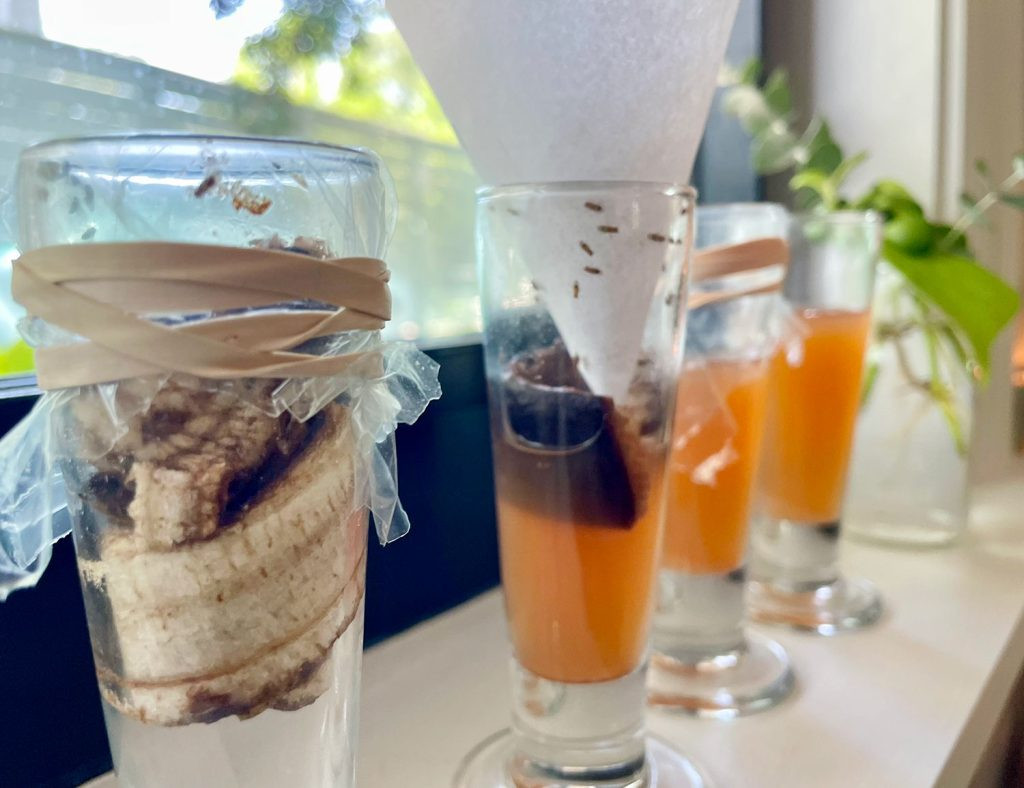 4 DIY Fruit Fly Traps Close Up
4 DIY Fruit Fly Traps Close Up
Our results indicated that the lure was more critical than the trap type. Traps using banana peel significantly outperformed those using only apple cider vinegar. While both Plastic Wrap Traps were structurally similar, the one baited with banana peel captured far more fruit flies than the ACV + soap trap. This suggests that while apple cider vinegar is effective, real fruit is even more enticing to fruit flies.
Therefore, our recommendation is to add a piece of fruit to any trap you set up, regardless of the trap design. We slightly preferred the plastic wrap trap for its ease of construction and stability. I accidentally tipped over the funnel trap once, releasing some flies back into the kitchen – oops!
What Attracts Fruit Flies the Most?
Intrigued by the success of fruit scraps, I expanded our experiment to determine which type of fruit was the most effective bait. We tested three readily available fruits: banana peel, apple slices, and a strawberry. Each fruit was placed in a separate Plastic Wrap Trap, set side-by-side on the countertop for 24 hours.
While the banana peel initially seemed promising (being the most ripe at the start), fruit flies were most attracted to the strawberry. The banana peel still captured a good number of flies, but the strawberry’s attractiveness increased as it ripened further. Interestingly, the apple slices didn’t catch any fruit flies at all!
Store-Bought Fruit Fly Trap Options
If DIY solutions aren’t working for you, or if you prefer a ready-made option, several effective store-bought fruit fly traps are available. These traps have overwhelmingly positive reviews and are generally priced under $20. They might be a good option if you want a trap that also catches other types of flying insects or if you prefer a more discreet trap design.
 Collage of Storebought Fruit Fly Traps
Collage of Storebought Fruit Fly Traps
During our experiment, I purchased a pack of Terro Fruit Fly Traps to compare their performance against our homemade traps. I placed a Terro trap next to our banana and strawberry traps for 24 hours to compare their effectiveness.
Again, our homemade strawberry trap performed best, closely followed by the banana peel trap. The store-bought trap only caught a single fruit fly in the first 24 hours. HOWEVER…
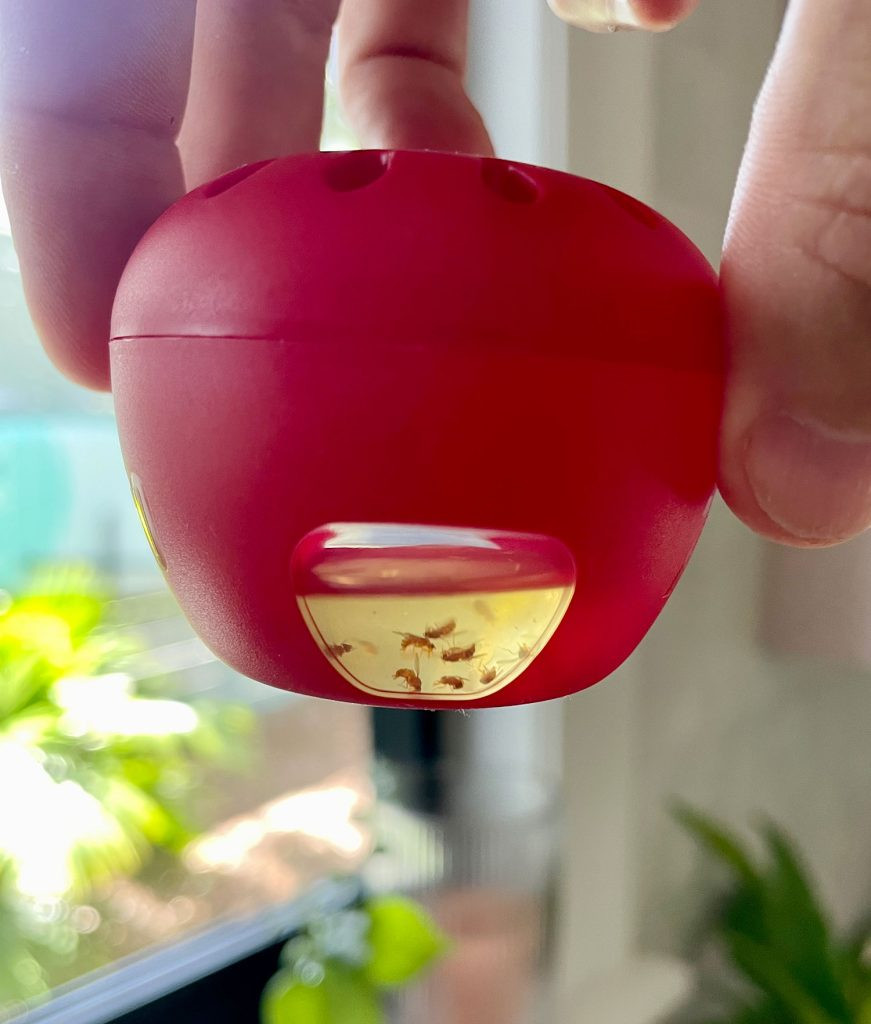 Terro Fruit Fly Trap With Dead Fruit Flies Visible
Terro Fruit Fly Trap With Dead Fruit Flies Visible
To ensure a fair comparison, we discarded the DIY traps and left the store-bought trap out for another 24 hours. Over this extended period, it captured a significant number of fruit flies, as pictured above. So, store-bought traps are effective, just not as immediately or intensely as our homemade traps. Our conclusion? Choose store-bought traps if you prefer a more subtle appearance, especially for long-term placement. However, homemade traps are highly effective for quickly addressing a fruit fly problem!
Preventing Fruit Flies: Key Strategies
While eliminating fruit flies is relatively straightforward, preventing infestations is even better. Here are simple steps to keep fruit flies from establishing themselves in your home:
- Maintain clean kitchen surfaces: Regularly wipe down countertops, stovetops, tables, and any surfaces prone to food residue or spills. Fruit flies are especially attracted to fruit, sugary liquids, and alcohol, so prompt cleanup is essential!
- Regularly empty trash cans: Food scraps left in your garbage, especially overnight, can quickly become a breeding ground for fruit flies.
- Promptly dispose of overripe fruit: Regularly check your fruit bowl for overripe or rotting fruits like apples and bananas, and discard them before they attract pests.
- Wash produce immediately upon bringing it home: Washing fruits and vegetables as soon as you get home from the store (except for berries, which are best washed just before use) can remove any fruit fly eggs or larvae that may be present.
- Refrigerate produce when possible: Fruit flies do not thrive in cold temperatures. Storing fruits and vegetables in the refrigerator, especially ripe ones, can deter infestations.
- Keep sink drains clean: Food particles in sink drains can attract fruit flies. Regularly run your garbage disposal and flush drains with hot water or a drain cleaner.
Finally, don’t panic if you spot fruit flies in your home. While it’s important to act quickly to prevent the issue from worsening, the solutions outlined in this guide are easy to implement, effective, and fast-acting. You might even find yourself enjoying the process of becoming a fruit fly scientist, just like I did!
*This post contains affiliate links, so we may earn a small commission when you make a purchase through links on our site at no additional cost to you.
